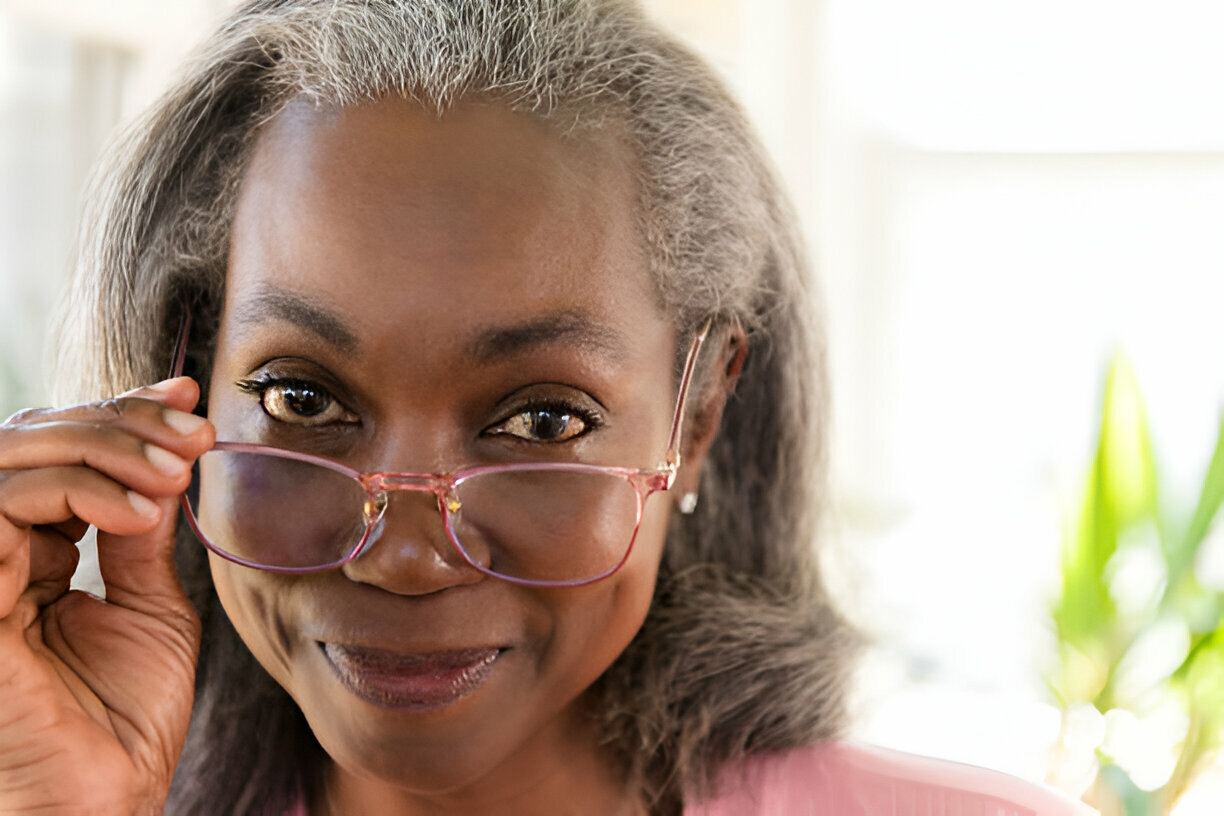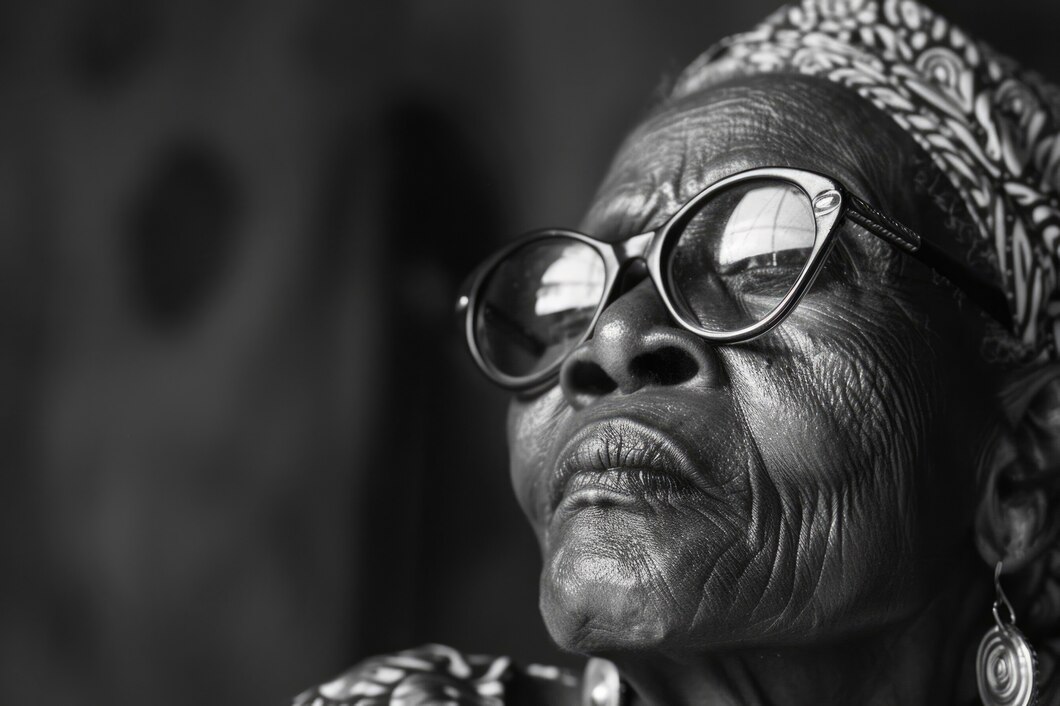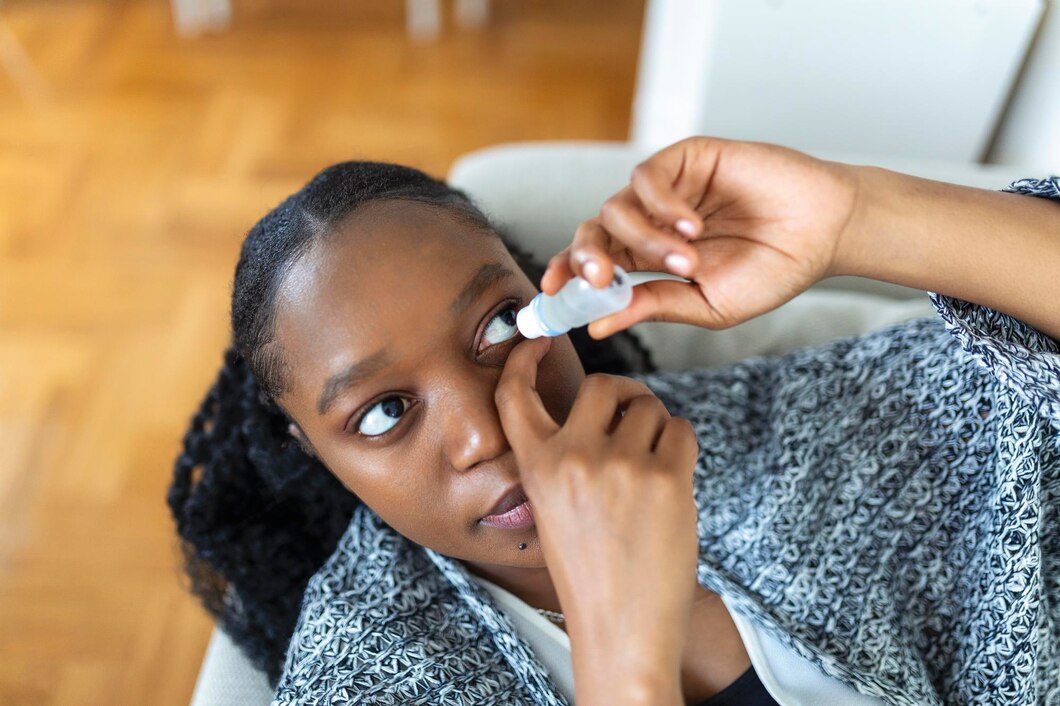Tips for Taking Care of Your Vision as You Age
By: Elizabeth Obigwe, B.Sc. Anatomy. Freelance Health Writer. Medically reviewed by A. Odutola, MBBS., PhD, FRCSEd.

Photo of a senior professional African woman with reading glasses.
Vision is considered the most important of our senses hence, eye health is important regardless of age. However, it is even more important to care for ageing eyes because just like our muscles and bones, our eyes naturally start to wear down a bit as we age. Without proper care and early interventions, these changes to the eyes may happen faster or become worse than they could have been.
If you are a senior citizen or have elderly people around you, keep reading.
This article shares useful information on the common conditions associated with ageing eyes and how to care for your eyes as you age in order to help maintain healthy eyes and a better life experience in general.

Monochrome portraait of an elderly African woman Image credit: Freepik
Macular degeneration occurs when a part of the eye called the macula gets damaged over time. The macula is located at the back of your eyeball and on the retina. The retina is a tissue that lines the inner surface of the eyeball and it is responsible for processing images received from the environment and sending them to the brain for interpretation.
The macula is the area of the retina from where you have your sharpest vision (central vision). I.e., it makes you see details clearly.
Damage to the macula can result in loss of vision.
There are two types of AMD:
Dry AMD – This type of AMD progresses slowly and your vision may still be normal despite subtle changes like the build-up of small yellow deposits on your retina, called Drusen. Over time, the macula thins out, making your central vision blurry or dim. This is the more common of the two types of AMD.
Wet AMD – The wet AMD is less common and has a faster progression than the dry one. It is also more severe. In this case, abnormal blood vessels grow under the macula, leak fluid, and cause progressive or sudden vision loss.
The exact cause of AMD is unknown. Genetics and environmental factors are suspected.
The risk factors for the development of AMD include:
Initially people with AMD may not notice any complaints.
Eventually, they might struggle with blurring of vision centrally making activities like reading, recognising faces or driving difficult. The side (peripheral) vision of people with AMD usually remains okay.
While there’s no cure, eye care for age-related macular degeneration includes lifestyle changes, vitamins, and injections, which can help slow its progression.
.jpg)
Photo of eyeball showing mature cataract
Cataracts occur when your eye lens which is usually clear becomes cloudy, making your vision blurry, hazy, or dim. Everything loses its sharpness and brightness. Regardless of the care for ageing eyes, everyone has a chance of developing cataracts if they live long enough. However, not everyone will develop the condition in their lifetime because it progresses over time and more slowly in some people.
Depending on the size and location of the cataract, you may experience minimal or severe visual disturbance.
If the cataract starts to interfere with your day-to-day activities like driving, watching television, or reading, your doctor may recommend surgery. The procedure will involve removing the cloudy lens and replacing it with a clear artificial lens to restore vision.
Get more details about the Causes, Risk factors, Symptoms and Treatment of Cataract from here.
.jpg)
A black and white photo of an elderly African woman wearing reading glasses. Image credit: Freepik
Diabetic retinopathy occurs when high blood sugar damages the tiny blood vessels in the retina, which is the part of the eye that helps you see. Anyone with diabetes is at risk of developing diabetic retinopathy. Hence, it is important to monitor and control your blood sugar and also get your eyes checked regularly if you are diabetic.
At first, you may not notice any changes, but as the damage gets worse, your vision can become blurry. Also, you may see dark spots (like floating specks), or even lose vision completely. This can affect both central and peripheral (side) vision.
Treatment for diabetic retinopathy depends on the severity of your condition, your age, and your general health. Treatments include laser surgery, injections, and eye surgery and are needed primarily when eye screening detects serious problems and your vision is being threatened.
.jpg)
Elderly African man at risk for glaucoma
Glaucoma can affect anybody, but it is more common among adults who are 60 years and older. It is an eye disease that damages the optic nerve, which is like a cable that sends visual information from your eye to your brain. This damage is usually caused by high pressure inside the eye (known as intraocular pressure or IOP).
Glaucoma has no symptoms in the beginning. As such, many people do not realise they have it. Over time, it starts affecting peripheral vision, making it harder to see things around you. If it gets worse, it can lead to tunnel vision and, eventually, blindness if not treated.
The damage caused by glaucoma cannot be reversed. Hence, early detection through regular eye checkups is important. Treatments like eye drops, laser therapy, or surgery can help lower eye pressure and prevent further vision loss.

An adult African woman dropping eye lubricants to treat dry eyes.Image credit: Freepik
Although not as severe as others, dry eye is still a problem for the ageing population. It happens when your eyes don’t make enough tears or when the tears dry up too quickly.
When your eyes do not make enough tears to lubricate it properly, they will:
Additional symptoms may include:
Using artificial tears (eye drops), a home humidifier or an air purifier, and avoiding dry environments are helpful ways to care for ageing eyes with this problem as they can help relieve the discomfort.
For more severe cases, your physician may recommend medications; tear duct plugs, or surgery.
Pay attention to the older adults around you. If you see them exhibiting these behaviours, they could be signs of aging eyes or poor eyesight that needs professional attention:
It is best to start eye care for old age early, as these general best practices benefit both the young and the elderly. Below are some of the things you can start doing at home to care for your sight.
Nutrition: Minimise junk foods and eat more fresh and healthy meals rich in vitamins and minerals. These are beneficial for your eyes. Thankfully, there are lots of African foods that are great for eye health.
Hydration: Drink enough water regularly as dehydration can make dry eyes worse.
Eye Protection: Use sunglasses with UV protection when outdoors to shield your eyes from harmful rays.
Screen Time Management: Limit screen time. But if you have to be on the screen for long, use the 20-20-20 rule: every 20 minutes, look at something 20 feet away for at least 20 seconds.
Moisturising Drops: For a person with dry eyes, consider using artificial tears or lubricating eye drops to reduce dryness, especially in dry environments.
Avoid Smoking: Stop smoking and avoid exposure to secondhand smoke, as it can worsen eye conditions like cataracts and macular degeneration.
Health Conditions: Properly managing health conditions that are linked to eye problems like diabetes and high blood pressure is also a necessary care for ageing eyes.
Stay Active: Exercise improves blood circulation in the eyes, ensuring that the eyes receive adequate nutrients and oxygen. This can help maintain optimal eye function and health. It can also reduce the risk of diseases like diabetes and high blood pressure which can contribute to loss of vision.
It is important to go for regular eye checkups because most eye diseases do not show early warning signs or symptoms. Generally, it is recommended that you get your eyes checked at least once every two years. However, if you are 65 years and older or at high risk of developing an eye problem, you should check your eyes yearly or as your doctor recommends.
You should see a doctor immediately if you notice any of these changes to your vision:
Like with most health concerns, exercise, nutrition and lifestyle modifications can make a significant impact on eye health. Although some age-related eye problems cannot be completely avoided, they can be slowed down or managed to prevent extreme deterioration.
Paying attention to changes in vision or unusual behaviours in older adults can help detect problems early. Also, regular eye checkups are crucial, as many eye diseases develop without early symptoms.
1. Rakow PL. Treating the aging eye. Optometry Times. 2015:1-5. [Accessed 3 Jan. 2025]. Available from here.
2. Berry P, Mascia J, Steinman BA. Vision and hearing loss in older adults: "Double trouble". Care Management Journals. 2004; 5(1):35–40. doi: 10.1891/cmaj.5.1.35.61260. Available from here.
Related:
Published: February 18, 2025
© 2025. Datelinehealth Africa Inc. All rights reserved.
Permission is given to copy, use and share content freely for non-commercial purposes without alteration or modification and subject to attribution as to source.
DATELINEHEALTH AFRICA INC., is a digital publisher for informational and educational purposes and does not offer personal medical care and advice. If you have a medical problem needing routine or emergency attention, call your doctor or local emergency services immediately, or visit the nearest emergency room or the nearest hospital. You should consult your professional healthcare provider before starting any nutrition, diet, exercise, fitness, medical or wellness program mentioned or referenced in the DatelinehealthAfrica website. Click here for more disclaimer notice.